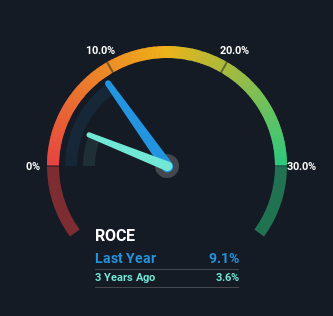Stock Analysis
- Sweden
- /
- Specialty Stores
- /
- OM:HM B
Returns On Capital Signal Tricky Times Ahead For H & M Hennes & Mauritz (STO:HM B)

If you're not sure where to start when looking for the next multi-bagger, there are a few key trends you should keep an eye out for. Typically, we'll want to notice a trend of growing return on capital employed (ROCE) and alongside that, an expanding base of capital employed. Ultimately, this demonstrates that it's a business that is reinvesting profits at increasing rates of return. Although, when we looked at H & M Hennes & Mauritz (STO:HM B), it didn't seem to tick all of these boxes.
Return On Capital Employed (ROCE): What Is It?
Just to clarify if you're unsure, ROCE is a metric for evaluating how much pre-tax income (in percentage terms) a company earns on the capital invested in its business. To calculate this metric for H & M Hennes & Mauritz, this is the formula:
Return on Capital Employed = Earnings Before Interest and Tax (EBIT) ÷ (Total Assets - Current Liabilities)
0.091 = kr10b ÷ (kr188b - kr77b) (Based on the trailing twelve months to August 2023).
Therefore, H & M Hennes & Mauritz has an ROCE of 9.1%. On its own that's a low return on capital but it's in line with the industry's average returns of 9.1%.
View our latest analysis for H & M Hennes & Mauritz

Above you can see how the current ROCE for H & M Hennes & Mauritz compares to its prior returns on capital, but there's only so much you can tell from the past. If you'd like to see what analysts are forecasting going forward, you should check out our free report for H & M Hennes & Mauritz.
The Trend Of ROCE
In terms of H & M Hennes & Mauritz's historical ROCE movements, the trend isn't fantastic. Over the last five years, returns on capital have decreased to 9.1% from 26% five years ago. However it looks like H & M Hennes & Mauritz might be reinvesting for long term growth because while capital employed has increased, the company's sales haven't changed much in the last 12 months. It may take some time before the company starts to see any change in earnings from these investments.
On a separate but related note, it's important to know that H & M Hennes & Mauritz has a current liabilities to total assets ratio of 41%, which we'd consider pretty high. This effectively means that suppliers (or short-term creditors) are funding a large portion of the business, so just be aware that this can introduce some elements of risk. Ideally we'd like to see this reduce as that would mean fewer obligations bearing risks.
What We Can Learn From H & M Hennes & Mauritz's ROCE
In summary, H & M Hennes & Mauritz is reinvesting funds back into the business for growth but unfortunately it looks like sales haven't increased much just yet. Since the stock has gained an impressive 53% over the last five years, investors must think there's better things to come. However, unless these underlying trends turn more positive, we wouldn't get our hopes up too high.
One more thing to note, we've identified 2 warning signs with H & M Hennes & Mauritz and understanding them should be part of your investment process.
While H & M Hennes & Mauritz may not currently earn the highest returns, we've compiled a list of companies that currently earn more than 25% return on equity. Check out this free list here.
Valuation is complex, but we're helping make it simple.
Find out whether H & M Hennes & Mauritz is potentially over or undervalued by checking out our comprehensive analysis, which includes fair value estimates, risks and warnings, dividends, insider transactions and financial health.
View the Free AnalysisHave feedback on this article? Concerned about the content? Get in touch with us directly. Alternatively, email editorial-team (at) simplywallst.com.
This article by Simply Wall St is general in nature. We provide commentary based on historical data and analyst forecasts only using an unbiased methodology and our articles are not intended to be financial advice. It does not constitute a recommendation to buy or sell any stock, and does not take account of your objectives, or your financial situation. We aim to bring you long-term focused analysis driven by fundamental data. Note that our analysis may not factor in the latest price-sensitive company announcements or qualitative material. Simply Wall St has no position in any stocks mentioned.
About OM:HM B
H & M Hennes & Mauritz
H & M Hennes & Mauritz AB (publ) provides clothing, accessories, footwear, cosmetics, home textiles, and homeware for women, men, and children worldwide.
Flawless balance sheet with solid track record.

